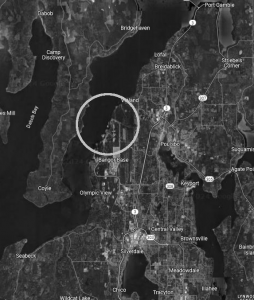But back to accidents. When subs return after a tour, they have their tires rotated. Except in this case it’s missiles. Two missiles get gently lifted up and serviced after every trip. This happens about four to six times a month (2 missiles, 2 – 3 times per month).
Missile handling is the most dangerous operation they do at Bangor. It’s the reason they have blast zones and reinforced buildings. (Note: Base Personnel are moved back during missile handling operations however no alerts are ever made to the public who are traveling on the waterway or nearby beaches within the blast zones.)

Aerial view of Bangor blast zone.
On Monday November 3, 2003, during a routine service, a ladder was left in the missile sleeve while being unloaded. When the missile was lifted it hit the ladder, which tore through the nose cone, stopping inches from striking the nuclear warheads and third stage rocket motor.
Now I know what you’re thinking, “Thank god it didn’t hit the nuclear warheads!”, right? Turns out it’s the third stage rocket motor we should be most concerned about. The rocket motors are highly explosive and the basis for the distances used in determining the size of the blast zones at Bangor. Had the ladder struck the rocket motor, there was a reasonable chance of an explosion that would have damaged and scattered the five – six plutonium warheads, essentially turning each nuclear warhead into a dirty bomb. There was also a reasonable chance of a cascading effect detonating the other 22 – 23 missiles on the sub. (Note: the Navy’s refusal to show proof that the cascading effect would not occur when seeking accreditation for the 2nd Explosive Handling Wharf at Bangor, was the reason the facility is not currently certified by the Department of Defense Explosives Safety Board (DDESB)). So it was a big deal.
But it didn’t happen.
At least as far as the public was concerned, it didn’t happen. That night on the news there was no mention of the accident at the site of the most powerful weapons system on the planet. There was no mention to law enforcement, local civilian emergency personnel, elected officials, no one. The U.S. premiere nuclear weapons facility came within two-three inches of a full-blown disaster and the plan was that per U.S. nuclear weapons policy, it was never going to be reported to the public.
A big part of public acceptance of nuclear weapons is built on the perception that nuclear weapons accidents are extremely rare and if they were to occur, the U.S. military has done everything in its power to mitigate the damage. Unfortunately, that’s not the case. The military views safety as a trade-off with other factors like costs and mission importance. Many (if not all) military bases in the U.S. have exceeded their initial footprints in terms of what they (not us) consider safe operating distances. From their viewpoint it’s simply too expensive to purchase the necessary property surrounding the bases to make them safe by today’s standards. They frame it as the public encroaching on their bases. And there’s a case to be made that the Bangor Base may very well be the poster child for the worst example of this (in the U.S. if not the world).
Fast forward from November 3rd to December 19th, six and a half weeks later. Commanding Officer Capt. Keith Lyles’ who was in charge of Bangor on November 3rd, is relieved of his command for “lack of confidence”.
It would be another week before Mike Barber at the Seattle-PI would write about Captain Lyles’ dismissal (Christmas Eve, December 24th) but there was no mention of the near miss nuclear missile mishap. The Navy almost never mentions details of its “lack (or loss) of confidence” dismissals. That was all we were ever going to know. The plan was to never tell us.
On March 11, 2004, over four months after the accident, news broke with details of the mishap, following a blog post by former Navy officer Walter Francis Fitzpatrick, III (Jaghunter). Had Walter not stepped up as the whistleblower as well as those who shared their stories with him, it’s very likely we would have never heard about the worst accident at Bangor “that never happened”.
Mike McCormick works with the Ground Zero Center for Nonviolent Action.
REFERENCES/FURTHER READING:
Bangor officer in charge of key missile systems loses his command; December 24, 2003; https://www.seattlepi.com/seattlenews/article/bangor-officer-in-charge-of-key-missile-systems-1133028.php
Weapons crew at Bangor damaged nuclear missile; March 11, 2004; https://archive.seattletimes.com/archive/?date=20040311&slug=missile11m
Missile incident rattles Canada; March 12, 2004; https://www.seattlepi.com/seattlenews/article/missile-incident-rattles-canada-1139507.php
Safety board rejected new explosive wharf at Bangor; October 1, 2012; https://archive.kitsapsun.com/news/local/safety-board-rejected-new-explosive-wharf-at-bangor-ep-417105448-356492641.html/
Puget Sound’s ticking nuclear time bomb; January 9, 2017; https://crosscut.com/2017/01/nuclear-accidents-bangor-accident-command-and-control
Peace organizations win legal fees and the release of eleven previously court-sealed Navy records showing new explosives risk at Naval Base Kitsap-Bangor; October 29, 2020; https://www.gzcenter.org/peace-organizations-win-legal-fees-and-the-release-of-eleven-previously-court-sealed-navy-records-showing-new-explosives-risk-at-naval-base-kitsap-bangor/




